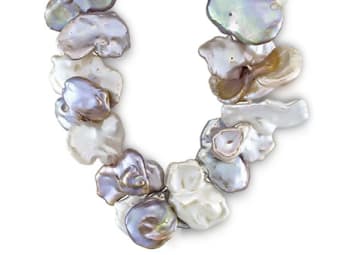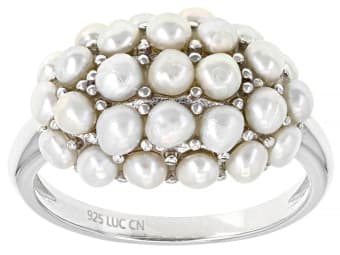Freshwater Pearls are harvested from mollusks, primarily mussels, native to rivers, lakes, and ponds. The first cultured freshwater pearls came from Lake Biwa in Japan and were call Biwa pearls. Today the Chinese produce most of the cultured freshwater pearls in the market. Rice pearl is the first term used to describe tissue-nucleated pearls from China. They get their name because they resemble grains of rice. Soufflé pearls are a freshwater variety from China that exhibit high iridescence and luster and irregular free form shapes. Tennessee freshwater pearls are harvested from the native Washboard mussel indigenous to the Tennessee rivers and streams.
General Information
LWUV: Variable
Freshwater Pearl Colors
-
 Black
Black -
 Blue
Blue -
 Brown
Brown -
 Gray
Gray -
 Green
Green -
 Orange
Orange -
 Pink
Pink -
 Purple
Purple -
 Red
Red -
 White
White -
 Yellow
Yellow
Alternate Names
Kasumiga Pearl
Countries of Origin
Colombia; Viet Nam; Japan; United States of America; Thailand; French Polynesia; India; Unknown; China; Namibia; Brazil; Italy; Israel; Bulgaria; Chile; Nepal; Indonesia
History
Welcome a wonder-filled addition to your jewelry collection: the humble freshwater pearl. This gemstone grows in a mussel, in a fashion that's similar to its more storied pearl cousins. Don't let this one slip through your fingers. Freshwater pearls are more prevalent, can be easily dyed to reflect a myriad of colors and they are often crazy affordable.
Care
Pearls are softer than most other gemstones. Keep your pearls separate and protected from dirt and dust. Pearls should be last on when you dress and first off in the evening. Chemicals like hairspray and perfume can damage your pearls - keep pearls away from them. Clean pearls after each wearing with a soft, dry, cloth.
More About Freshwater Pearl
If you enjoy the legends and stories that surround gemstones, you'll be glad to know that freshwater pearls have taken their place beside several of their more storied pearl relatives. Those who believe in the power of gems attribute the freshwater pearl with the ability to give wisdom and cement engagements, improve financial positions, protect the wearer, and keep children safe. The early Chinese legends include the story that pearls fall from the sky when dragons fight. Other legends suggest that pearls are the tears of the Gods.
Species/Variety
Keshi Pearls
A happy accident of pearl farming, keshi pearls are produced by chance. Saltwater oysters sometimes reject their bead implant, but particles of the accompanying mantle tissue remain and stimulate the production of nacre in flat, petal-like shapes. They are often removed as seed pearls, inspiring their name, meaning "poppy seed" in Japanese. While some people think they should be considered natural pearls, they are a by-product of the culturing process so this is not technically correct. One of the most striking characteristics of South Sea keshi pearls is their very intense luster and iridescence, sometimes greater than seen in the finest cultured pearls.
Seed Pearls
Seed pearls are very tiny, round, usually natural pearls that are under two millimeters in size. They are rarely seen today, but often found in antique jewelry or sewn into vintage clothing. Seed pearls can be produced by both freshwater and saltwater mollusks.


